Why you can trust Tom's Hardware
Like all Asus gaming monitors, the XG27UQ defaults to its Racing picture mode. You can calibrate the image, but we found little need for adjustment. The factory calibration is sound and supported by an included data sheet.
Grayscale and Gamma Tracking
Our grayscale and gamma tests are described in detail here.
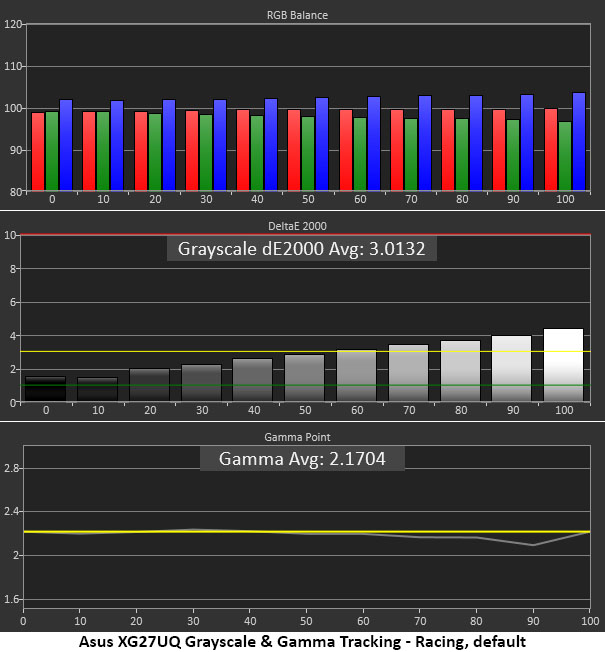
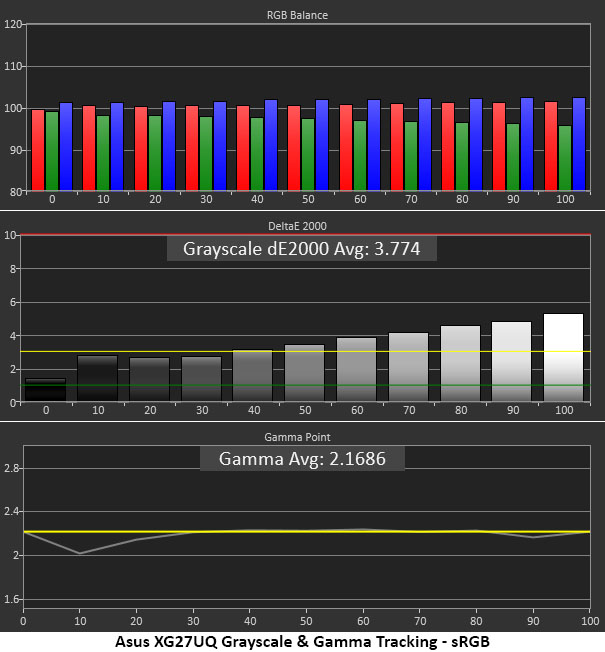
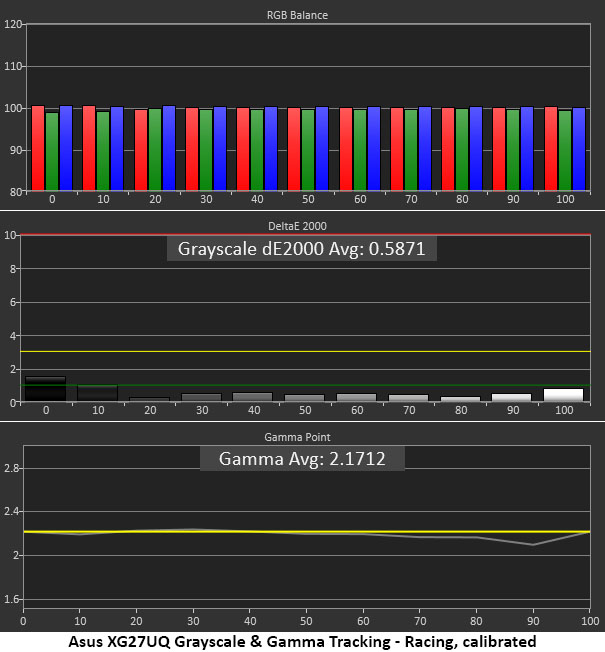
The out-of-box white point is slightly blue from 70% brightness and higher, but the error is almost invisible. Coupled with excellent gamma tracking, the XG27UQ makes our calibration-not-required list.
With a few tweaks to the RGB sliders however, the average error is now as low as any professional monitor can boast. Gamma remains solid with perfect tracking up to 70% and only a slight dip thereafter. This is excellent performance.
Asus includes an accurate sRGB mode that only has a slight purple error visible or 60% and higher brightness. Gamma tracks well at 2.2 except for 10% gray which is a little lighter than spec. If you’re a color purist, this mode is effective for SDR content. We wish it had adjustable brightness though, that slider is locked out and peak brightness is fixed at 180 nits.
Comparisons
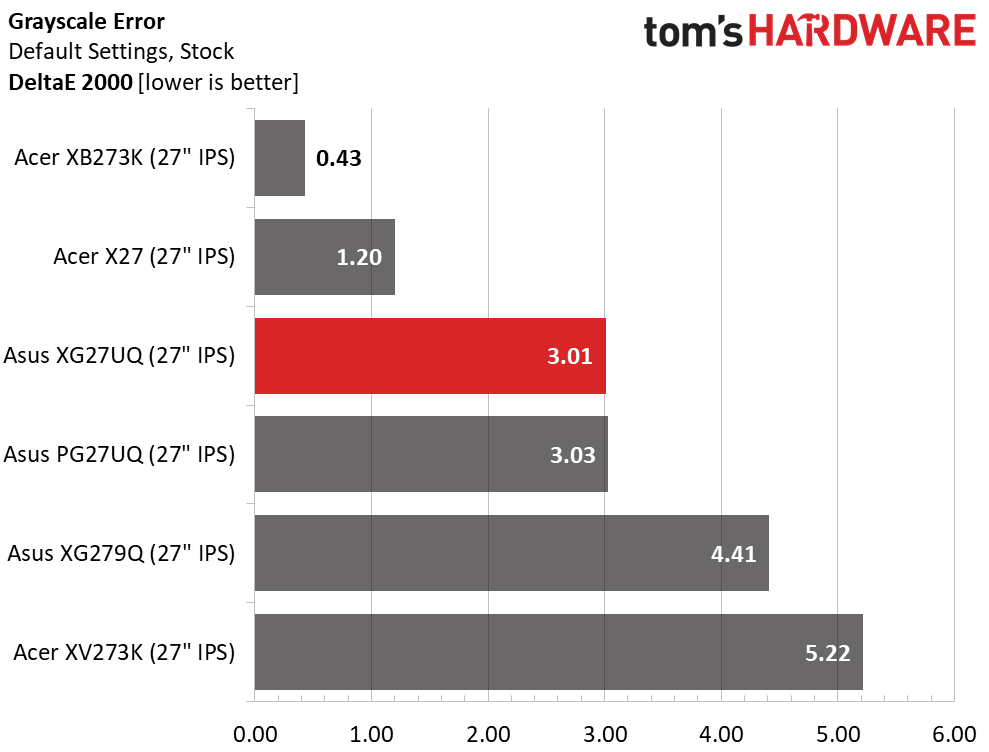
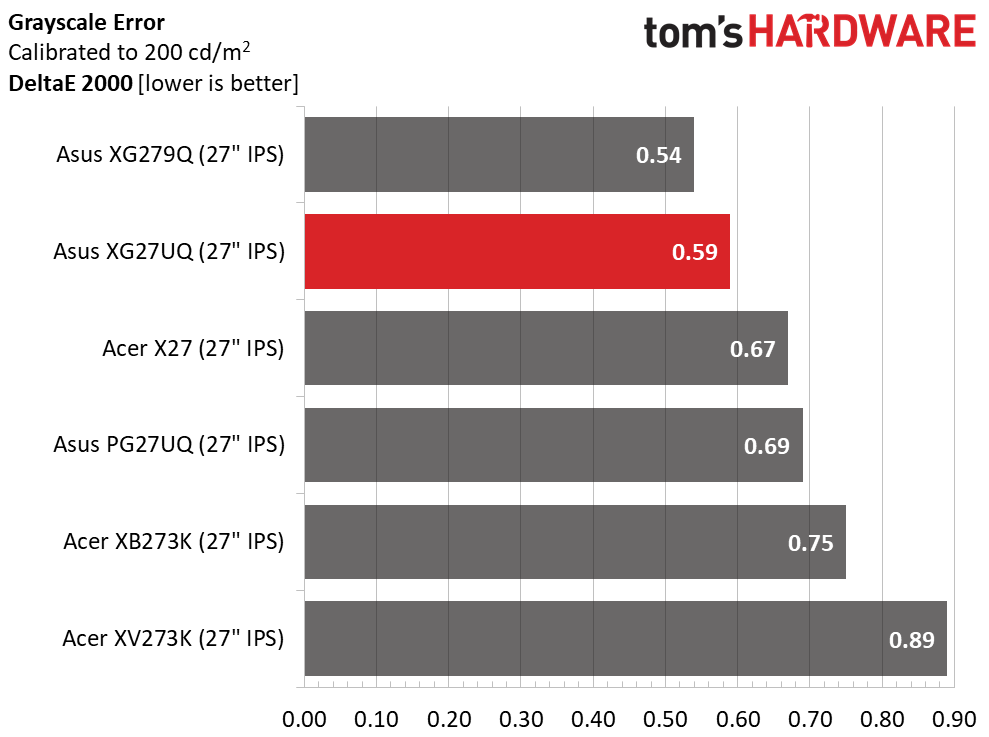
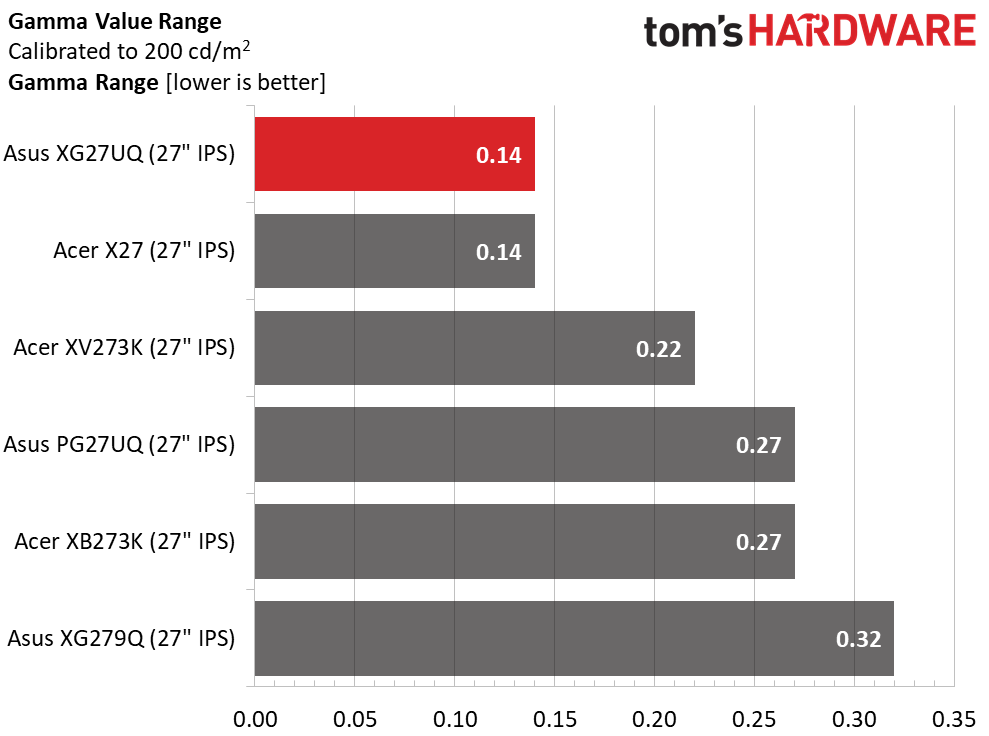
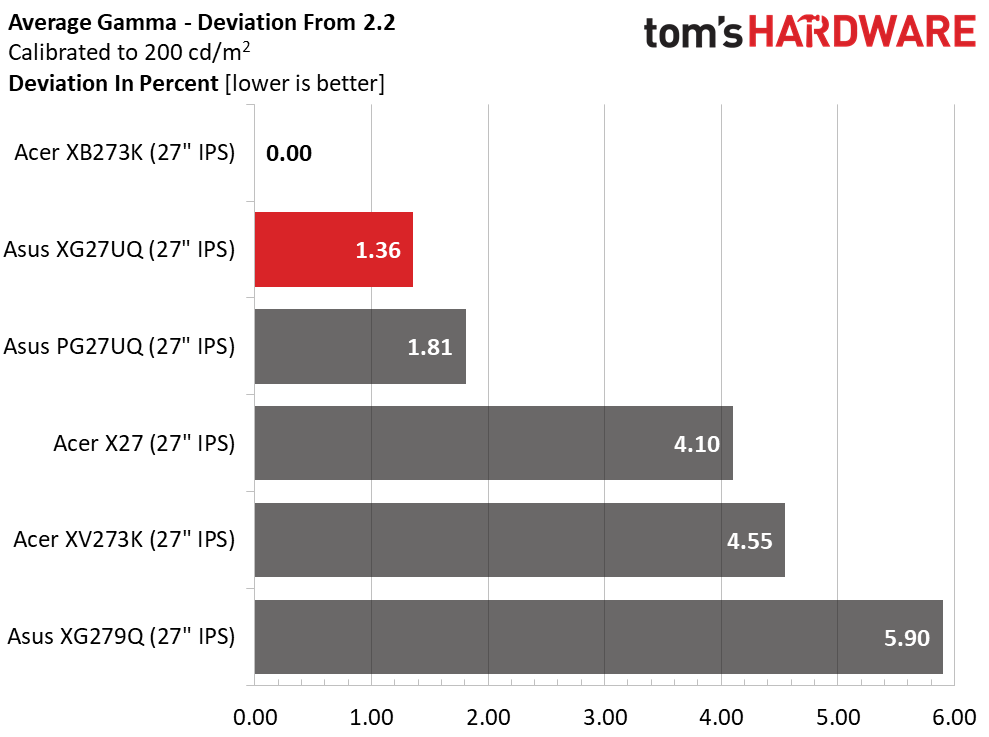
With a default grayscale error of 3.01dE, the XG27UQ can be enjoyed without calibration. The slight blue tint we observed in test patterns is hard to spot in real-world content. If you can calibrate, or you choose to dial in our recommended settings, the error will be reduced to well below the visible threshold. 0.59dE is about as close to perfect as grayscale tracking gets.
In any case, gamma tracking is exemplary. Most of the luminance range is locked onto the 2.2 line with a little lightness from 70-90%. Again, this is hard to see in actual content. We have no complaints about the XG27UQ’s image accuracy. As you’ll see in the next section, color tracking is equally fine.
Get Tom's Hardware's best news and in-depth reviews, straight to your inbox.
Color Gamut Accuracy
For details on our color gamut testing and volume calculations, please click here.
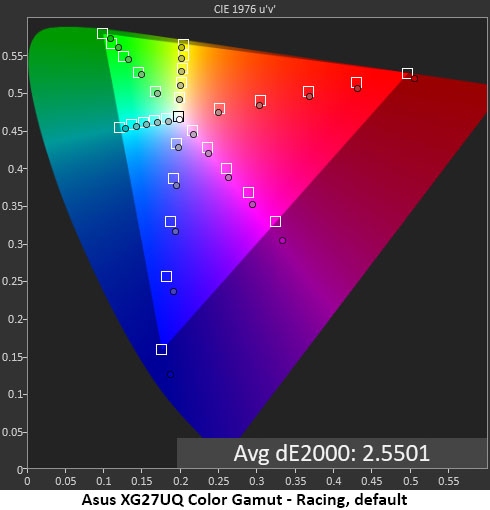
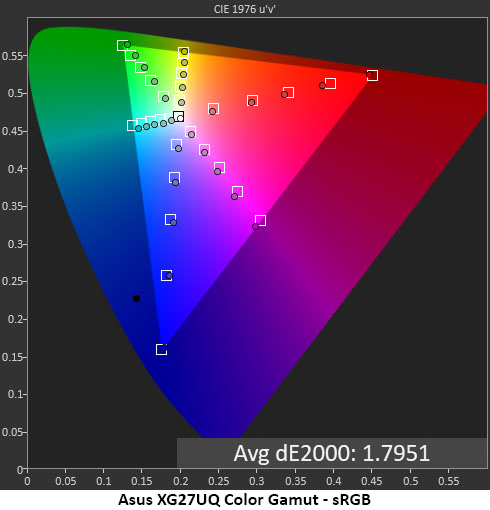
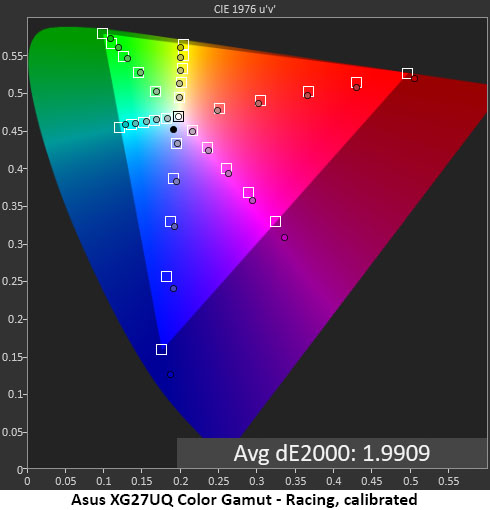
The XG27UQ’s Racing mode also means you’ll engage its full native color gamut for SDR content. Asus claims 90% coverage of DCI-P3, and our tests confirm that. In fact, you’ll get a little bonus blue, magenta and red. Green is slightly under but that is a barely visible error.
Calibration lowers the average error from invisible to slightly more invisible by virtue of improvements to secondary color hues. It doesn’t get much better than this.
The sRGB mode can’t be adjusted but its color is quite accurate. Aside from slight hue errors in cyan and magenta, there are no issues here. The XG27UQ is one of the few extended color monitors that has a truly usable sRGB mode.
Comparisons
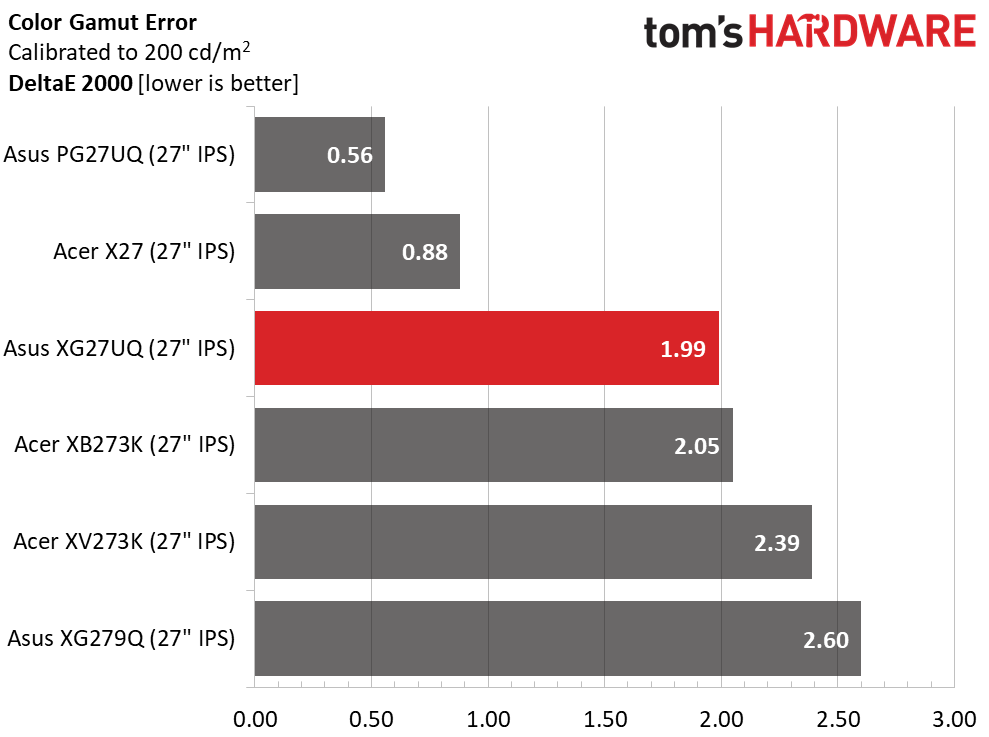
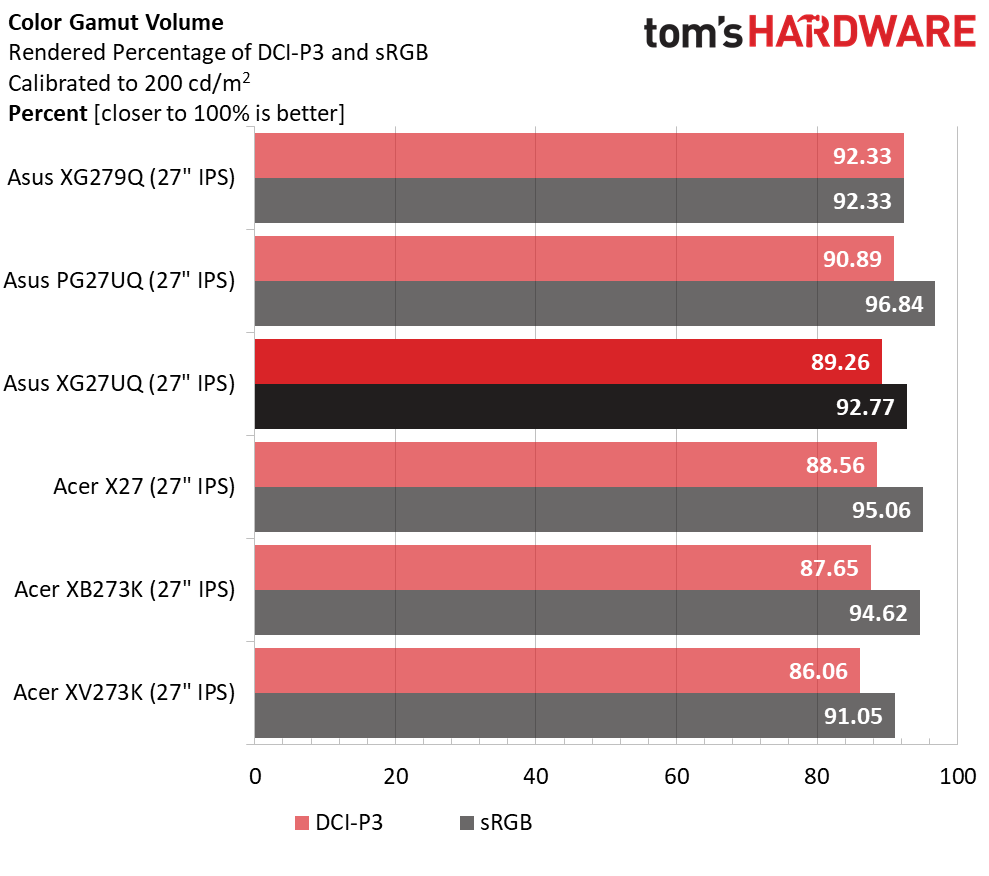
A 1.99 Delta E (dE) score puts the XG27UQ into third place behind the more expensive PG27UQ and X27. None of these displays will give any user cause for concern; they are all extremely color accurate.
With only a slight under-saturation in green and cyan, the XG27UQ nearly fills the entire DCI-P3 gamut. Asus claims 90%, and our measurement of 89.27% is quite close. Again, only the more expensive X27 and PG27UQ boast more volume ,and that’s only by the slimmest of margins. The XG27UQ is perfectly qualified for color-critical work and will satisfy any gamer or entertainment seeker with its color reproduction.
Current page: Grayscale, Gamma and Color
Prev Page Brightness and Contrast Next Page HDR Performance
Christian Eberle is a Contributing Editor for Tom's Hardware US. He's a veteran reviewer of A/V equipment, specializing in monitors. Christian began his obsession with tech when he built his first PC in 1991, a 286 running DOS 3.0 at a blazing 12MHz. In 2006, he undertook training from the Imaging Science Foundation in video calibration and testing and thus started a passion for precise imaging that persists to this day. He is also a professional musician with a degree from the New England Conservatory as a classical bassoonist which he used to good effect as a performer with the West Point Army Band from 1987 to 2013. He enjoys watching movies and listening to high-end audio in his custom-built home theater and can be seen riding trails near his home on a race-ready ICE VTX recumbent trike. Christian enjoys the endless summer in Florida where he lives with his wife and Chihuahua and plays with orchestras around the state.
-
law records 1.) Does the monitor have a fan? I've read about how loud monitor fans can be, so the ideal monitor for me wouldn't have one.Reply
2.) Does this panel have FALD? I suspect it doesn't, given the price.
3.) How big a difference is there between Gsync compatible and "proper" G-sync? I have a "proper" G-sync monitor with the chip, but it looks like more and more screens are just going with the "compatible" version which doesn't. I read some of the technical differences, but curious about how noticeable it is when gaming.
I have an 1080ti and will be upgrading to a 3080 once supply stabilizes. -
truerock So, DisplayPort 1.4 supports a maximum of 4K UHD (3840 \00d7 2160) at 60 Hz with 30 bit/px RGB color and HDR .Reply
You couldn't have tested 144MHz.
Oh... I think you may have used compression.
If you use compression I think there should be some details about that in your testing... or at least clearly state: "this is a test with compression" for each test using compression. -
Shadowclash10 I don't think saying it's expensive compared to other 27 inchers is a good con. It's a somewhat premium 4K 144hz monitor, what did you expect? Now, one con is that is has very large and ugly bezels.Reply -
veldrane2 WTB 120Hz+, 4k, sub 4ms, 29-34" monitor.Reply
I've been stuck on 27 inchers for about a decade now. Going to another is not really an upgrade. Double this due to increase in quality of 2k.
So its kinda pointless. We have all this wonderful new hardware cpming out that can finally run 4k really, really well, and monitor manufacturers in general seem to be just derping around instead of pumping out full lines of HBR3 displays.
And no, I don't want it to be TV sized. Not 43", not 55" or whatever else, just an upgrade from not into 27".
Maybe someone at Tom's Hardware could reach out to some of these manufacturers and do a write up about this hold up. Might turn out to be a good topic for an article. -
Bisbus I would definitely second this. There simply aren't any 32" high refresh rate monitors out. Especially with the 3080 coming out it seems manufacturers are caught behind the times.Reply -
excalibur1814 Manufacturers aren't caught behind the times, they're just lazy and will continue to churn out the same, tired, old tech as they're making money. I have a simple, standard, Asus VS248HR which cost £120. It's terrible, but does what it does. I left a reasonable review on Amazon, to which Asus replied as they didn't like what I'd written.Reply
These companies will continue releasing rubbish, at the lower end, to ensure anything above 'standard' affords a premium. Typical, standard, every single day profit. Heck, we'd still be on 1366x768 if they had their way.
P.s. It would be amazing if these companies also made it 100% clear if the 3.5m jack audio/heaphone out was linked to the hdmi port. -
peteer01 Talks about DSC as if it helps with image lag instead of calling it out as necessary compression because DisplayPort 1.4 doesn’t natively support the bandwidth needed for 144Hz 4KReply
Says you can count the number of 4K 144Hz monitors on one hand
Doesn’t bother to list the lack of HDMI 2.1 (which has more bandwidth than DP1.4) under cons or in the part of the article I readI stopped couldn't get through this advertisement. The misinformation is frustrating. I get it, you write reviews that make products look good, but can you avoid lies and misinformation? -
Jackal_x How does it compare to the LG 27GN950?Reply
im pretty stuck atm for what i should buy, maybe its worth waiting to see if theres more options in the next few months with HDMI 2.1 support? -
kyzarvs Replylaw records said:
2.) Does this panel have FALD? I suspect it doesn't, given the price.
Today, we’ll be looking at a less-expensive alternative that delivers everything except the FALD backlight for $800 as of writing. Meet the Asus ROG Strix XG27UQ.
The sentence that includes the price - second paragraph. -
Shadowclash10 Reply
Yeah. Sadly, that;s how the majority of tech companies run. If they have no competition, why push hard and innovate? The only reason is so that an upstart doesn't come along and dethrone them. Just look at Intel! There are so many improvements they could easily make for consumers, but they don't because consumers are "content".excalibur1814 said:Manufacturers aren't caught behind the times, they're just lazy and will continue to churn out the same, tired, old tech as they're making money. I have a simple, standard, Asus VS248HR which cost £120. It's terrible, but does what it does. I left a reasonable review on Amazon, to which Asus replied as they didn't like what I'd written.
These companies will continue releasing rubbish, at the lower end, to ensure anything above 'standard' affords a premium. Typical, standard, every single day profit. Heck, we'd still be on 1366x768 if they had their way.
P.s. It would be amazing if these companies also made it 100% clear if the 3.5m jack audio/heaphone out was linked to the hdmi port.